The AMD Ryzen 5 1600X vs Core i5 Review: Twelve Threads vs Four at $250
by Ian Cutress on April 11, 2017 9:00 AM ESTBenchmarking Performance: CPU Office Tests
The office programs we use for benchmarking aren't specific programs per-se, but industry standard tests that hold weight with professionals. The goal of these tests is to use an array of software and techniques that a typical office user might encounter, such as video conferencing, document editing, architectural modelling, and so on and so forth. At present we have two such tools to use.
PCMark8
Despite originally coming out in 2008/2009, Futuremark has maintained PCMark8 to remain relevant in 2017. On the scale of complicated tasks, PCMark focuses more on the low-to-mid range of professional workloads, making it a good indicator for what people consider 'office' work. We run the benchmark from the commandline in 'conventional' mode, meaning C++ over OpenCL, to remove the graphics card from the equation and focus purely on the CPU. PCMark8 offers Home, Work and Creative workloads, with some software tests shared and others unique to each benchmark set.
Chromium Compile (v56)
Our new compilation test uses Windows 10 Pro, VS Community 2015.3 with the Win10 SDK to combile a nightly build of Chromium. We've fixed the test for a build in late March 2017, and we run a fresh full compile in our test. Compilation is the typical example given of a variable threaded workload - some of the compile and linking is linear, whereas other parts are multithreaded.
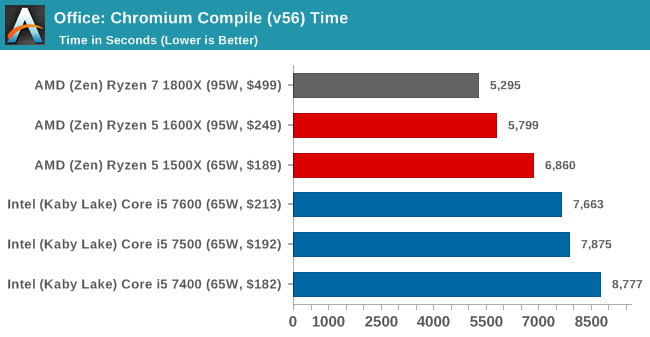
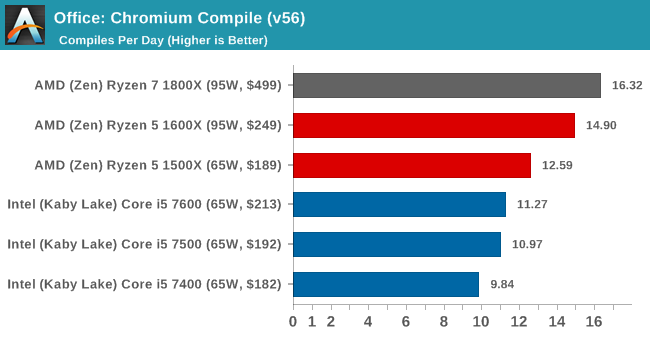
SYSmark 2014 SE
SYSmark is developed by Bapco, a consortium of industry CPU companies. The goal of SYSmark is to take stripped down versions of popular software, such as Photoshop and Onenote, and measure how long it takes to process certain tasks within that software. The end result is a score for each of the three segments (Office, Media, Data) as well as an overall score. Here a reference system (Core i3-6100, 4GB DDR3, 256GB SSD, Integrated HD 530 graphics) is used to provide a baseline score of 1000 in each test.
A note on contect for these numbers. AMD left Bapco in the last two years, due to differences of opinion on how the benchmarking suites were chosen and AMD believed the tests are angled towards Intel processors and had optimizations to show bigger differences than what AMD felt was present. The following benchmarks are provided as data, but the conflict of opinion between the two companies on the validity of the benchmark is provided as context for the following numbers.







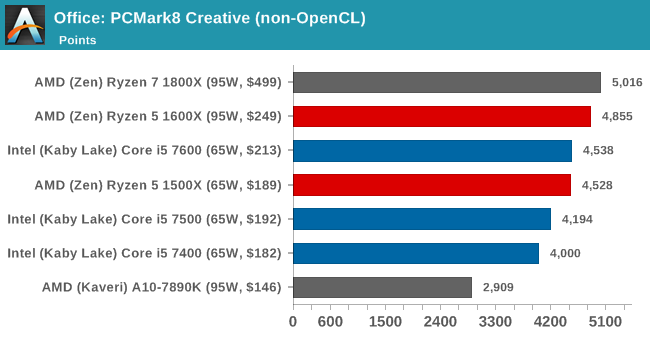
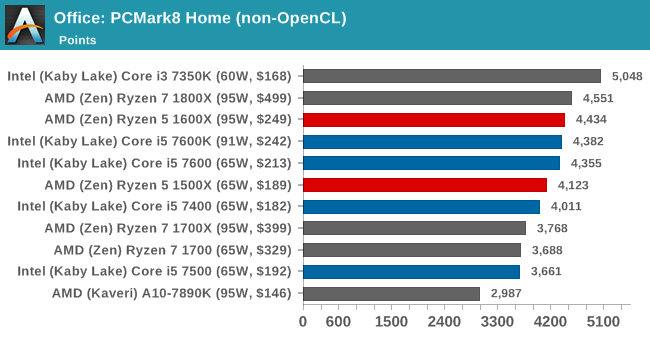
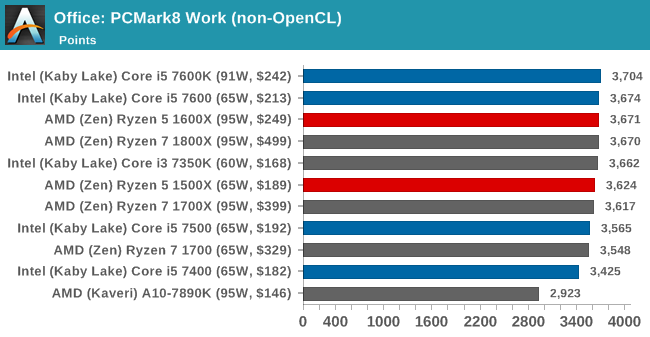








254 Comments
View All Comments
802Shaun - Tuesday, April 11, 2017 - link
Just a friendly correction: It should be "200% more threads" instead of 300% more. Thanks for the article!Ian Cutress - Tuesday, April 11, 2017 - link
Updated :)ChristopherF - Tuesday, April 11, 2017 - link
Wouldn't 300% be correct since 12 is 3x 4?mickulty - Tuesday, April 11, 2017 - link
It has 300% of the threads, but has 200% *more* threads.buri - Tuesday, April 11, 2017 - link
Your logic is correct if you say "3 times", but with percentages you always refer to the % amount more. In this case is 8 threads more, so 200% of 4 threads. 6 threads more would have been 150% more, and so onMobiusPizza - Tuesday, April 11, 2017 - link
It's either 200% MORE threads or 300% the original thread count.ddriver - Tuesday, April 11, 2017 - link
Nice to see AMD not only back in the game, being competitive in trivial computing workloads, but also offering TWICE the value where PERFORMANCE really MATTERS - rendering, encoding, compiling and other time intensive workloads.MajGenRelativity - Tuesday, April 11, 2017 - link
Indeed it is. I recently built a PC with a 1700X, and my friend said it was a massive improvement over his old FX 6350SquarePeg - Tuesday, April 11, 2017 - link
I'm wondering how low AMD's pricing will go on R3 chip's if they can bring a 4C/4T low end R3 to market for $99 that can overclock decently then the FX 6300/6350 will have a true successor.MajGenRelativity - Tuesday, April 11, 2017 - link
That's also something I'm interested in. Right now it reaches down to $170, which is still in the upper mid-range, but if it can go even further down, I'd be pretty happy with it.